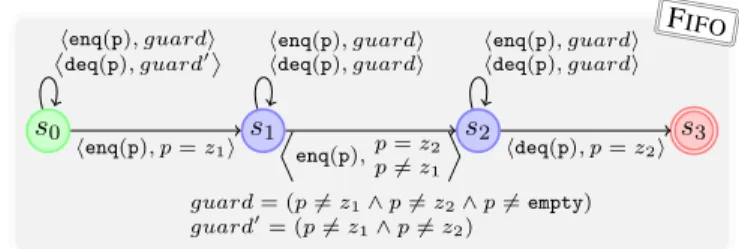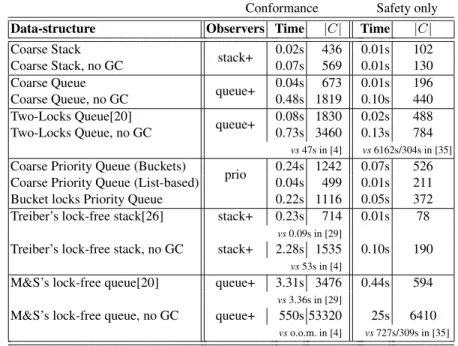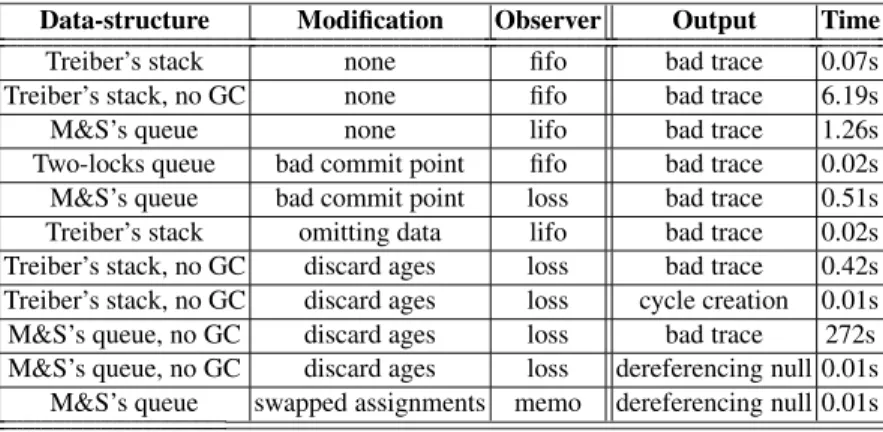for Highly Concurrent Data Structures
Parosh Aziz Abdulla 1 , Frédéric Haziza 1 , Lukáš Holík 1 , 2 , Bengt Jonsson 1 , and Ahmed Rezine 3
1
Uppsala University, Sweden
2
Brno University of Technology, Czech Republic
3
Linköping University, Sweden
Abstract. We present a technique for automatically verifying safety properties of concurrent programs, in particular programs which rely on subtle dependen- cies of local states of different threads, such as lock-free implementations of stacks and queues in an environment without garbage collection. Our technique addresses the joint challenges of infinite-state specifications, an unbounded num- ber of threads, and an unbounded heap managed by explicit memory allocation.
Our technique builds on the automata-theoretic approach to model checking, in which a specification is given by an automaton that observes the execution of a program and accepts executions that violate the intended specification. We extend this approach by allowing specifications to be given by a class of infinite-state au- tomata. We show how such automata can be used to specify queues, stacks, and other data structures, by extending a data-independence argument. For verifica- tion, we develop a shape analysis, which tracks correlations between pairs of threads, and a novel abstraction to make the analysis practical. We have imple- mented our method and used it to verify programs, some of which have not been verified by any other automatic method before.
1 Introduction
In this paper, we consider one of the most difficult current challenges in software ver- ification, namely to automate its application to algorithms with an unbounded number of threads that concurrently access a dynamically allocated shared state. Such algo- rithms are of central importance in concurrent programs. They are widely used in li- braries, such as the Intel Threading Building Blocks or the java.util.concurrent pack- age, to provide efficient concurrent realizations of simple interface abstractions. They are notoriously difficult to get correct and verify, since they often employ fine-grained synchronization and avoid locking wherever possible. A number of bugs in published algorithms have been reported [10,19]. It is therefore important to develop efficient techniques for verifying conformance to simple abstract specifications of overall func- tionality, a concurrent implementation of a common data type abstraction, such as a
Supported in part by the Uppsala Programming for Multicore Architectures Research Center (UPMARC), the Czech Science Foundation (project P103/10/0306), and the CENIIT research organization (project 12.04).
N. Piterman and S. Smolka (Eds.): TACAS 2013, LNCS 7795, pp. 324–338, 2013.
c Springer-Verlag Berlin Heidelberg 2013
queue, should be verified to conform to a simple abstract specification of a (sequential) queue.
We present an integrated technique for specifying and automatically verifying that a concurrent program conforms to an abstract specification of its functionality. Our start- ing point is the automata-theoretic approach to model checking [30], in which programs are specified by automata that accept precisely those executions that violate the intended specification, and verified by showing that these automata never accept when they are composed with the program. This approach is one of the most successful approaches to automated verification of finite-state programs, but is still insufficiently developed for infinite-state programs. In order to use this approach for our purposes, we must address a number of challenges.
1. The abstract specification is infinite-state, because the implemented data structure may contain an unbounded number of data values from an infinite domain.
2. The program is infinite-state in several dimensions: it (i) consists of an unbounded number of concurrent threads, (ii) uses unbounded dynamically allocated memory, and (iii) the domain of data values is unbounded.
3. The program does not rely on automatic garbage collection, but manages memory explicitly. This requires additional mechanisms to avoid the ABA problem, i.e., that a thread mistakenly confuses an outdated pointer with a valid one.
Each of these challenges requires a significant advancement over current specification and verification techniques.
We cope with challenge 1 by combining two ideas. First, we present a novel tech- nique for specifying programs by a class of automata, called observers. They extend automata, as used by [30], by being parameterized on a finite set of variables that as- sume values from an unbounded domain. This allows to specify properties that should hold for an infinite number of data values. In order to use our observers to specify queues, stacks, etc., where one must “count” the number of copies of a data value that have been inserted but not removed, we must extend the power of observers by a second idea. This is a data independence argument, adapted from Wolper [34], which implies that it is sufficient to consider executions in which any data value is inserted at most once. This allows us to succinctly specify data structures such as queues and stacks, using observers with typically less than 3 variables.
To cope with challenge 2(i), we would like to adapt the successful thread-modular approach [4], which verifies a concurrent program by generating an invariant that cor- relates the global state with the local state of an arbitrary thread. However, to cope with challenge 3, the generated invariant must be able to express that at most one thread accesses some cell on the global heap. Since this cannot be expressed in the thread- modular approach, we therefore extend it to generate invariants that correlate the global state with the local states of an arbitrary pair of threads.
To cope with challenge 2(ii) we need to use shape analysis. We adapt a variant of
the transitive closure logic by Bingham and Rakamari´c [5] for reasoning about heaps
with single selectors, to our framework. This formalism tracks reachability properties
between pairs of pointer variables, and we adapt it to our analysis, in which pairs of
threads are correlated. On top of this, we have developed a novel optimization, based
on the observation that it suffices to track the possible relations between each pair of
pointer variables separately, analogously to the use of DBMs used in reasoning about timed automata [9]. Finally, we cope with challenge 2(iii) by first observing that data values are compared only by equalities or inequalities, and then employing suitable standard abstractions on the concerned data domains.
We have implemented our technique, and applied it to specify and automatically ver- ify that a number of concurrent programs are linearizable implementation of stacks and queues [16]. This shows that our new contributions result in an integrated technique that addresses the challenges 1 – 3, and can fully automatically verify a range of concurrent implementations of common data structures. In particular, our approach advances the power of automated verification in the following ways.
– We present a direct approach for verifying that a concurrent program is a lineariz- able implementation of, e.g., a queue, which consists in checking a few small prop- erties of the algorithm, and is thus suitable for automated verification. Previous approaches typically verified linearizability separately from conformance to a sim- ple abstraction, most often using simulation-based arguments, which are harder to automate than simple property-checking.
– We can automatically verify concurrent programs that use explicit memory man- agement. This was previously beyond the reach of automatic methods.
In addition, on examples that have been verified automatically by previous approaches, our implementation is in many cases significantly faster.
Overview. We give an overview of how our technique can be used to show that a con- current program is a linearizable implementation of a data structure. As described in Section 2, we consider concurrent programs consisting of an arbitrary number of se- quential threads that access shared global variables and a shared heap using a finite set of methods. Linearizability provides the illusion that each method invocation takes effect instantaneously at some point (called the linearization point) between method invocation and return [16]. In Section 3, we show how to specify this correctness condi- tion by first instrumenting each method to generate a so-called abstract event whenever a linearization point is passed. We also introduce observers, and show how to use them for specifying properties of sequences of abstract events. In Section 4, we introduce the data independence argument that allows observers to specify queues, stacks, and other unbounded data structures. In Section 5, we describe our analysis for checking that the cross-product of the program and the observer cannot reach an accepting location of the observer. The analysis is based on a shape analysis, which generates an invariant that correlates the global state with the local states of an arbitrary pair of threads. We also introduce our optimization which tracks the possible relations between each pair of pointer variables separately. We report on experimental results in Section 6. Section 7 contains conclusions and directions for future work.
Related work. Much previous work on verification of concurrent programs has con-
cerned the detection of generic concurrency problems, such as race conditions,
atomicity violations, or deadlocks [14,22,23]. Verification of conformance to a simple
abstract specification has been performed using refinement techniques, which establish
simulation relations between the implementation and specification, using partly manual techniques [11,8,12,33].
Amit et al [3] verify linearizability by verifying conformance to an abstract specifi- cation, which is the same as the implementation, but restricted to serialized executions.
They build a specialized abstract domain that correlates the state (including the heap cells) of a concrete thread and the state of the serialized version, and a sequential refer- ence data structure. The approach can handle a bounded number of threads. Berdine et al [4] generalize the approach to an unbounded number of threads by making the shape analysis thread-modular. In our approach, we need not keep track of heaps emanating from sequential reference executions, and so we can use a simpler shape analysis. Plain thread-modular analysis is also not powerful enough to analyze e.g. algorithms with ex- plicit memory management. [4] thus improves the precision by correlating local states of different threads. This causes however a severe state-space explosion which limits the applicability of the method.
Vafeiadis [27] formulates the specification using an unbounded sequence of data val- ues that represent, e.g., a queue or a stack. He verifies conformance using a specialized abstraction to track values in the queue and correlate them with values in the imple- mentation. Like [25], our technique for handling values in queues need only consider a small number of data values (not an unbounded one), for which it is sufficient to track equalities. The approach is extended in [28] to automatically infer the position of linearization points: these have to be supplied in our approach.
Our use of data variables in observers for specifying properties that hold for all data values in some domain is related in spirit to the identification of arbitrary but fixed objects or resources by Emmi et al. [13] and Kidd et al. [18]. In the framework of regular model checking, universally quantified temporal logic properties can be compiled into automata with data variables that are assigned arbitrary initial values [1].
Segalov et al. [24] continue the work of [4] by also considering an analysis that keeps track of correlations between threads. They strive to counter the state-space explosion that [4] suffers from, and propose optimizations that are based on the as- sumption that inter-process relationships that need to be recorded are relatively loose, allowing a rather crude abstraction over the state of one of the correlated threads. These optimizations do not work well when thread correlations are tight. Our experimental evaluation in Section 6 shows that our optimizations of the thread correlation approach achieve significantly better analysis times than [24].
There are several works that apply different verification techniques to programs with a bounded number of threads, including the use of TVLA [35]. Several approaches produce decidability results under limited conditions [7], or techniques based on non- exhaustive testing [6] or state-space exploration [32] for a bounded number of threads.
2 Programs
We consider systems consisting of an arbitrary number of concurrently executing threads.
Each thread may at any time invoke one of a finite set of methods. Each method declares
local variables (including the input parameters of the method) and a method body. In this
paper, we assume that variables are either pointer variables (to heap cells), or data vari-
ables (assuming values from an unbounded or infinite domain, which will be denoted by
D). The body is built in the standard way from atomic commands using standard control flow constructs (sequential composition, selection, and loop constructs). Method execu- tion is terminated by executing a return command, which may return a value. The global variables can be accessed by all threads, whereas local variables can be accessed only by the thread which is invoking the corresponding method. We assume that the global variables and the heap are initialized by an initialization method, which is executed once at the beginning of program execution.
Atomic commands include assignments between data variables, pointer variables, or fields of cells pointed to by a pointer variable. The command new node() allo- cates a new structure of type node on the heap, and returns a reference to it. The cell is deallocated by the command free. The compare-and-swap command CAS(&a,b,c) atomically compares the values of a and b. If equal, it assigns the value of a to c and returns TRUE, otherwise, it leaves a unchanged and returns FALSE.
As an example, Figure 1 shows a version of the concurrent queue by Michael and Scott [20]. The program represents a queue as a linked list from the node pointed to by Head to a node that is either pointed by Tail or by Tail’s successor. The global vari- able Head always points to a dummy cell whose successor, if any, stores the head of the queue. In the absence of garbage collection, the program must handle the ABA prob- lem where a thread mistakenly assumes that a globally accessible pointer has not been changed since it previously accessed that pointer. Each pointer is therefore equipped with an additional age field, which is incremented whenever the pointer is assigned a new value.
The queue can be accessed by an arbitrary number of threads, either by an enqueue method enq(d) , which inserts a cell containing the data value d at the tail, or by a dequeue method deq(d) which returns empty if the queue is empty, and otherwise ad- vances Head, deallocates the previous dummy cell and returns the data value stored in the new dummy cell. The algorithm uses the atomic compare-and-swap (CAS) opera- tion. For example, the command CAS(&Head, head, next.ptr,head.age+1) at line 29 of the deq method checks whether the extended pointer Head equals the ex- tended pointer head (meaning that both fields must agree). If not, it returns FALSE.
Otherwise it returns TRUE after assigning next.ptr,head.age+1 to Head.
3 Specification by Observers
To specify a correctness property, we instrument each method to generate abstract events. An abstract event is a term of the form l ( d 1 , . . . , d n ) where l is an event type, taken from a finite set of event types, and d 1 , . . . , d n are data values in D. To specify linearizability, the abstract event l ( d 1 , . . . , d n ) generated by a method should be such that l is the name of the method, and d 1 , . . . , d n is the sequence of actual parameters and return values in the current invocation of the method. This can be established using standard sequential verification techniques.
We illustrate how to instrument the program of Figure 1 in order to specify that it is
a linearizable implementation of a queue. The linearization points are at line 9, 21 and
29. For instance, line 9 of the enq method called with data value d is instrumented to
generate the abstract event enq(d) when the CAS command succeeds; no abstract event
void initialize() { node* n := new node();
n → next.ptr := NULL;
Head.ptr := n;
Tail.ptr := n;
}
0
void enq(data d){
1
node* n := new node();
2
n → val := d;
3
n → next.ptr := NULL;
4
while(TRUE){
5
pointer_t tail := Tail;
6
pointer_t next := tail.ptr→next;
7
if(tail = Tail)
8
if(next.ptr = NULL)
9
if(CAS(&tail.ptr → next, next,
10
n,next.age+1 ))
11
break;
12
else
13
CAS(&Tail,tail, next.ptr, tail.age+1 );
14
}
15
CAS(&Tail, tail, n, tail.age+1 );
16
}
struct node {data val, pointer_t next}
struct pointer_t {node* ptr, int age}
pointer_t Head, Tail;
17
data deq(){
18
while(TRUE){
19
pointer_t head := Head;
20
pointer_t tail := Tail;
21
pointer_t next := head.ptr → next;
22
if(head = Head)
23
if(head.ptr = tail.ptr)
24
if(next.ptr = NULL)
25
return empty;
26
CAS(&Tail, tail, next.ptr, tail.age+1 );
27
else
28
data result := next.ptr → val;
29
if(CAS(&Head, head,
30
next.ptr,head.age+1 ))
31
break;
32
}
33
free(head.ptr);
34
return result;
35
}
INITENQ
DEQ
![Fig. 1. Michael & Scott’s non-blocking queue [20]](https://thumb-eu.123doks.com/thumbv2/1library_info/4152607.1554342/6.659.83.574.79.377/fig-michael-amp-scott-s-non-blocking-queue.webp)


